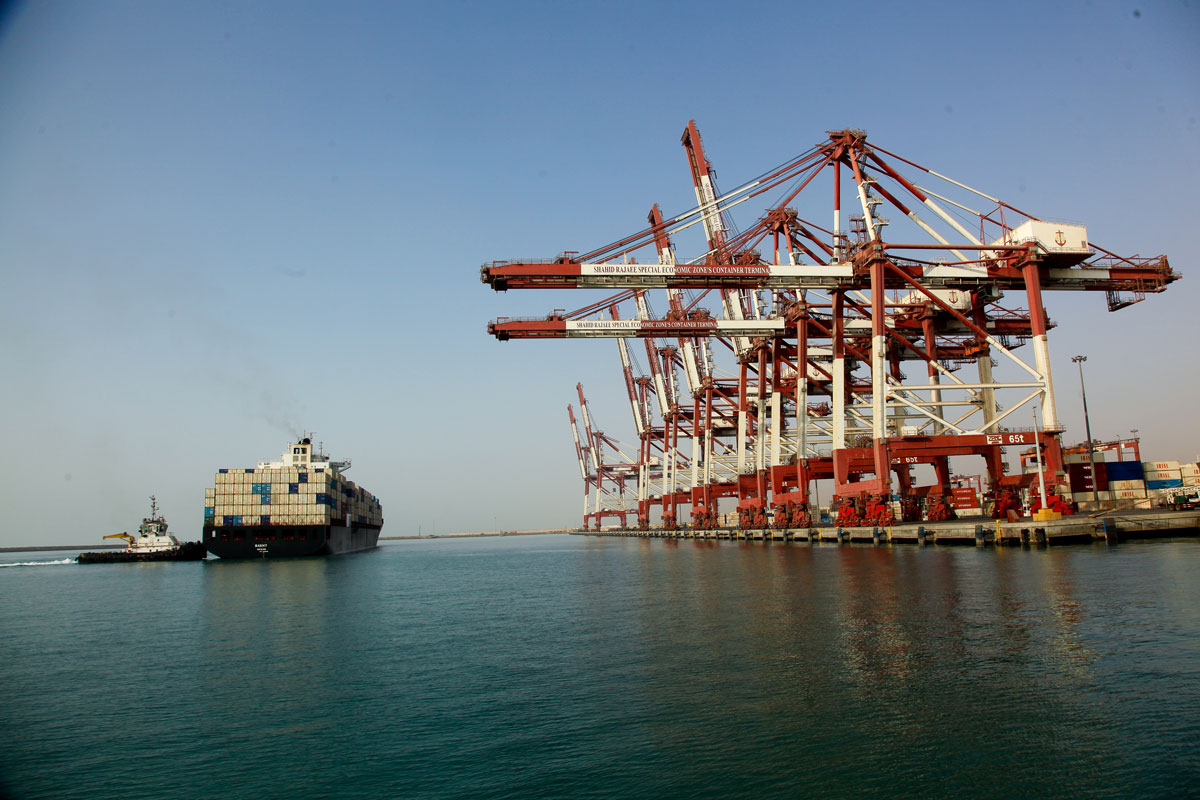The throughput of Iranian ports has increased under the government of President Hassan Rouhani.
Iranian port activities, which account for a considerable portion of Iran's foreign trade, increased considerably after Iran signed the nuclear deal with world powers in 2015, which led to the removal of economic sanctions against the country last year.
"According to the Islamic Republic of Iran Shipping Lines, maritime transportation accounts for 85% of Iran's foreign trade. Imam Khomeini and Shahid Rajaee ports in southern Iran account for 80% of the total throughput of Iranian ports," said Mohammad Saeedi, chief executive of IRISL.
Close to 145 million tons of oil and non-oil goods were loaded and unloaded in Iranian ports in the last Iranian year (ended March 20, 2017), registering a 4.3% rise compared to March 2013-14 when Rouhani came to power, the Ministry of Roads and Urban Development’s news service reported.
The ports handled 58.2 million TEU of containers last year, indicating a 162% hike over March 2013-14 after a sharp fall to 1.2 million TEU was registered in March 2014-15.
About 49 million tons of non-oil goods were exported from Iranian ports last year, up 11% compared to March 2013-14. However, non-imports saw a 6% decline to stand at 33 million tons.
Last year, 9,301 vessels berthed at Iranian ports, which show a 10% increase compared to March 2013-14. The number of ships docking at Iranian ports reached its peak of 9,534 during March 2015-16.
Marine passenger transportation rose 17% during the four years under review to 7.17 million passengers last year.
International shipping lines are increasingly sending their vessels to Iranian destinations that were previously blacklisted by sanctions.
Seventeen major global shipping lines have resumed their services to Iran since the removal of nuclear sanctions, CEO of Ports and Maritime Organization Mohammad Saeednejad said.
“As a result of the nuclear deal, Iran’s marine activities are now completely back to normal,” the official was quoted as saying in January.
Mediterranean Shipping Company, the world’s second-largest shipping line in terms of container vessel capacity, and Evergreen Line are among top shipping lines that have resumed cooperation with Iranian ports.
France’s CMA CGM, the world’s third largest container shipping group, called at Shahid Rajaei, Iran’s biggest container port at the mouth of Strait of Hormuz, in August 2016. The company teamed up with Islamic Republic of Iran Shipping Lines to share vessel capacity and jointly operate routes and marine container terminals.
Maersk Line expanded its footprint in Iran by adding a second port of call less than three months after it resumed services to the country following the lifting of sanctions. The Danish carrier, which suspended services in 2012, added the port of Bushehr to its Iran coverage in 2017. Its service was relaunched with calls to Bandar Abbas in October last year.
Iran is planning to develop container ports to increase the share of marine transportation. PMO says it expects to attract $700 million worth of investments within the next two years.
These investments will be in the form of new port equipment, which will be installed mainly in Shahid Beheshti Port in southeastern Chabahar and Shahid Rajaee Port in the southern port city of Bandar Abbas.
Shahid Rajaee, formerly the port of Bandar Abbas, is Iran’s largest port by tonnage throughput and the only port in the country to handle more than 10,000 TEUs in September.
Work is underway to expand container capacity at Shahid Rajaee and tenders for management contracts for upgrading facilities and the construction of a new 1.9-million-TEU transshipment terminal are expected to be issued by the end of this year.
Chabahar serves as Iran’s only oceanic port and consists of two ports, namely Shahid Kalantari and Shahid Beheshti.
Iran’s total non-oil foreign trade stood at $87 billion in the last Iranian year.
According to the Islamic Republic of Iran Customs Administration, Iran exported 129.648 million tons of non-oil commodities worth $43.93 billion last year, registering a 3.58% growth in total value of exports year-on-year.
Gas condensate was the main exported commodity, making up for $7.32 billion of the export value. It was followed by light oil, excluding gasoline ($2.49 billion), liquefied natural gases ($2.79 billion), liquefied propane ($1.222 billion) and petroleum gases and liquefied hydrocarbons ($1.204 billion).
Iran imported $43.684 billion worth of goods during the same period, marking a 5.16% growth. Field corn, soybean, cars, auto parts and rice were Iran’s main imports in the last Iranian year.
China remained the top export destination for Iranian goods. The Asian country imported 37.7 million tons of goods worth $8.177 billion in the last Iranian year, up 9.1% compared with the year before.
Other major export destinations were the UAE with $7.43 billion, Iraq with $6.1 billion, Turkey with $3.2 billion and South Korea with $2.8 billion.
Major exporters to Iran in 2016-17 included China ($10.73 billion), the UAE ($6.4 billion), South Korea ($3.46 billion), Turkey ($2.73 billion) and Germany ($2.53 billion).


